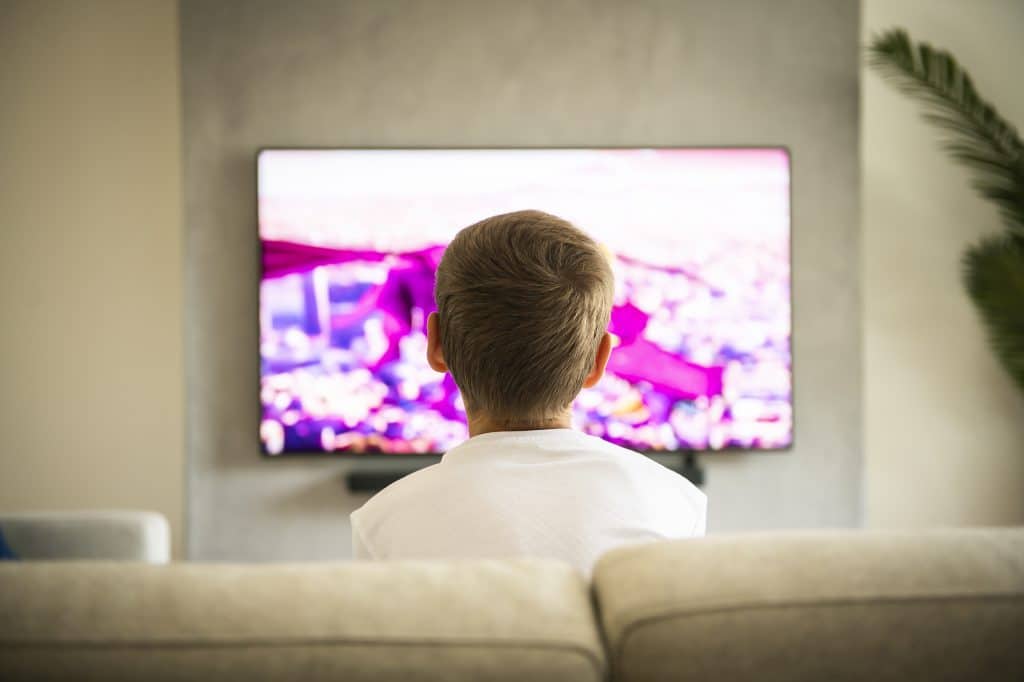It’s no secret that obesity has been a significant concern for decades. The World Health Organization (WHO) reports that in 2020, 39 million children under the age of 5 were reported overweight or obese (World Health Organization, 2021). The Centers for Disease Control and Prevention (CDC) warn that obesity rates among children are too high, stressing that their health will remain at risk unless positive changes are made (Centers for Disease Control and Prevention, 2021).
Evidence points to technology use as a significant contributor. During the pandemic, technology has become a tool to maintain a sense of normalcy and stability within the home. This increased reliance on technology and reduced access to physical activity may encourage sedentary behaviors in children, putting them at risk for physical and mental health challenges. Parents and caregivers are vital to establishing a healthy lifestyle. Fortunately, even small changes have a tremendously positive impact.
Preventing Obesity in Kids
Obesity is preventable and treatable
There are many reasons why a child may be struggling with obesity. If your child’s pediatrician has ruled out medical conditions, parents can then address other environmental factors such as a child’s food consumption, attitudes about food and eating, and physical activity habits.
In a study performed by the Harvard School of Public Health, children who watched television for more than 5 hours a day were five times more likely to be obese than children who had less than 2 hours of screen time a day (Gortmaker, 1996). Therefore, setting screen time limits is vital. The behaviors children learn are carried into their adolescent years and may continue into adulthood. Although poor habits are a challenge to break, all children can benefit from learning to self-regulate media consumption.
Ideas for discussion
Technology Can Be a Barrier to a Child’s Active Play

Most technology requires very little physical activity. Sedentary behaviors are beneficial as forms of relaxation throughout the day and should be expected in environments like school or work. However, prolonged or excessive resting behaviors come with risks, including obesity, reduced fitness, and poorer social and cognitive skills (Maitland, 2013). Focus on helping children balance physical and sedentary activities so that both are enjoyable. As parents, we never want screen time to dominate our children’s time and become a barrier to creativity and active play.
So, How Can You Help Your Child?
Encourage healthy eating habits
In general, experts agree that food intake is the primary focus when gaining, maintaining, and losing weight, meaning technology use is not the sole contributing factor.
One study found that while children are on screens they:
- eat more
- consume more calorie-dense foods
- eat fewer fruits and vegetables
- consume more carbonated soft drinks and fast food
- are more prone to skipping meals, eating larger portions, and mindless snacking
(Ying Ying, 2020). These eating habits, combined with sedentary behavior, contribute to the risk of obesity as children mature.

Should kids be put on a diet?
When it comes to making changes to a child’s eating habits, avoid putting them on a diet. Diets are often too restrictive, and the underlying message may lead children to develop disordered eating habits (Whyte, 2004). Instead, focus on teaching children to have a healthy relationship with food: listening to and honoring hunger cues, being able to eat in varied social environments without fear of judgment, being flexible with food preferences (if the situation calls for it), enjoying a variety of balanced meals, and confidently eating for both pleasure and hunger (Kronberg, 2021).
One way to build a healthy relationship with food is to focus on quality rather than quantity. It’s important not to moralize food by teaching children that certain foods are bad and others are good, as this may cause your child to develop food guilt. But parents can certainly encourage their children to be mindful of how different foods make them feel. The best way to start implementing these changes is to start gradually, only making a few changes at a time to avoid becoming overwhelmed. Getting the whole family involved in meal planning and eating meals together can help children feel less singled out and more supported in their family’s healthy lifestyle (WebMD, 2015).
Balance screen time & fun time
The American Academy of Child & Adolescent Psychiatry emphasizes the importance of finding a balance between screen time and physical activity (AACAP, 2020). While removing technology from your child’s daily routine isn’t necessary, parents should create a plan that prioritizes socialization, sleep, exercise, and media breaks.
A great place to start is to have a conversation with your family. Decide how much screen time is too much, where and when to use technology, prioritize screen time with other responsibilities, and add consequences for rule-breaking. In finding a balance that works for your family, you may offer enough space for children to play, offer children several choices for activities, and create a schedule that emphasizes spending time outside as a family.
Encourage physical over sedentary activities
The home environment is the most important place for children to learn physical and sedentary behaviors. The way parents use their influence to create an atmosphere conducive to active play has a major role in their children’s expanding interests and physical capabilities. Research shows that having equipment available in the home for children to engage with was not enough to encourage children to use it.
Even when children have ample space and opportunity to engage in physical activity, they gravitate to sedentary activities. Taking away technology completely or enforcing rules to reduce technology use fails to improve the situation. Without further parental support or guidance, children simply replace one sedentary behavior for another (Matiland, 2013).
Give kids an engaging alternative and let them lead the way. Be willing to allow them to try many things. When kids feel empowered to choose what interests them most, they are more likely to engage in active play. If unsupervised outdoor play is not safe, consider discussing options like jump ropes, nylon tunnels, and even cardboard boxes!
Avoid Restricting Outdoor Play

Sometimes daily life can get so hectic that it’s easy to fall back on technology to help us survive, but tech should be a last resort, not a go-to. Understandably, parents may set rules around outdoor play and physical activity due to lifestyle factors and safety concerns, but technology use is safest when it is intentional. As parents and caregivers, we can facilitate alternate opportunities for independent play and encourage playtime with neighborhood peers.
A safe environment is essential, but even while accompanying your child to a playground or park, encouraging them to explore will give them a chance to practice vital skills. Independent play provides unique experiences to cultivate resilience, find confidence and contentment, make decisions, and be creative (Maitland, C., 2013).
Allow the outdoors to spark your child’s curiosity, sense of adventure, and delight in discovery. This will form a positive attitude around active play, and children will be more likely to engage with the seemingly endless possibilities that exist outside the walls of their home. A recent study reported that young children whose parents restricted their outdoor play tended to engage in more sedentary behaviors. Children whose parents only set limitations around technology use naturally spent more time engaging in physical activities (Bassul, 2021).
It’s important to encourage children to explore the possibilities of outdoor settings. Research shows that indoor activities tend to be dominantly sedentary while outdoor activities tend to be more physically engaging. The mere act of getting outside is more likely to increase your child’s physical activity.
Assess Your Screen Time Use
The more parents use technology, the more their children do as well.
—Dr. Carolina Bassul, School of Biological and Health Sciences, Technological University Dublin 3
Researchers in Dublin have shown that the way parents behave and interact with technology plays an integral part in determining whether screen time is restricted or encouraged within the home (Bassul, 2021). Kids follow by example and tend to imitate their parents’ behaviors. This isn’t necessarily a negative thing as it means that parents can positively influence their children. Kids will be more likely to comply with rules placed around technology if they see parents reinforcing expectations by also following the rules.
Multiple studies have proven that the more parents used technology, the more their children did as well (Maitland, 2013; Totland, 2013). This trend grows exponentially over time. It is important to establish rules around technology use within the home and ensure that every family member respects those boundaries. As you transition your household schedule to include more active pursuits, be sure to include yourself.
Reconnect With Your Family
The way families spend time together contributes to overall sedentary behavior. Researchers found that when screen time is a shared family activity, parents also tend to be less restrictive of their children’s screen time, which leads to an increase in sedentary behavior (Bassul, 2021). Consequently, parents were more likely to use technology as a way to bond with their children as they grew older instead of engaging in more social contexts together (Totland, 2013). Active families saw a decrease in sedentary behavior (Maitland, 2013).

Establishing tech-free family time may be one option for getting away from screens and supporting face-to-face engagement. Parents who further participate in positive physical activities with their children will reinforce these habits and interrupt a cycle of learned sedentary behavior. As kids mature, the amount of independence, privacy, and parental control within the home will shift to taking on more responsibilities and garnering trust.
Avoid defining your family’s playtime solely by technology. It is never too late to start making healthy, sustainable lifestyle changes. Even a shift to walking together once a week will bring positive change. These efforts will improve the quality of life for your family overall.
Resources For Every Family

Depending on where you call home, it can be a significant challenge to find safe spaces to play. To combat this, the U.S. Soccer Foundation builds mini-pitches (playing fields) within communities that have limited access to safe play areas. Click here to learn more about this program. You’ll need to find a space that has a hard surface, like a parking lot or an underutilized tennis or basketball court. As long as the space is 4000-8000 square feet, it is eligible.

